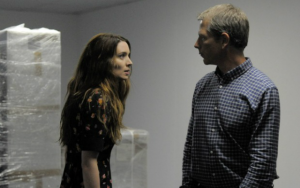Metro Canada: Una touches upon a very topical nerve of sex abuse.
 By Richard Crouse – Metro Canada
By Richard Crouse – Metro Canada
Based on the play Blackbird by Scottish playwright David Harrower, the new film Una is an uncomfortable look into an uncomfortable subject.
“In the theatre it is kind of like a verbal boxing match,” says Una’s director Benedict Andrews. “You are trapped in the same room with the two protagonists as they face each other off. There is a profound shift that happens once it becomes cinema. After living with the film for a while I think the film hurts a lot more than the play ever did.”
Rooney Mara plays the title character, a 20-something who takes action after seeing a picture of Ray, played by Ben Mendelsohn, in a magazine. The two have a past. Fifteen years earlier, when she was 13 and Ray was a middle-aged man, he seduced her, a crime he paid for with four years in prison.
Convinced his actions put her in a downward spiral, she goes to his place of work to confront him. He’s re-established himself with a new name, wife and job. She demands to know why he did what he did, and why he abandoned her when they were about to make a run for it and leave England to start a new life together.
Andrews first directed the play in November 2005 but had no interest in revisiting his previous work.
“There will continue to be fine productions of the play because it really is one of the best chamber plays of this century,” he says.
“It is rich material for actors and provocative and rich material for audiences. Neither of us wanted to make a well-made version of the play. It had to become distinct. I sometimes see them as two children coning from the same DNA. In many ways I’m trying to respect and amplify the core of the play.”
What might have been a straightforward story of a search for answers defies preconceived audience expectations with the ethical landmines Andrews and Harrower (who also wrote the script) plant along the way. In its most startling turn Una asks the audience to consider the interaction between Ray and Una, the abuser and the abused, as some kind of love story.
“This is about two people who see each other after 15 years,” he says, “the chemical charge of that meeting and their encounter is a profoundly cinematic idea. I was interested in how the camera might be able to pursue a special intimacy, the scar tissue opening up again between these two characters, and being able to microscope in on that scar tissue.”
Although the play was first performed 12 years ago, Andrews calls it “prescient” in the wake of recent events that have shone a light on sexual abuse in Hollywood.
“Part of the intelligence of the play is the way (Harrower) unpacks the moral problems of the survivor and the abuser relationship,” Andrews says.
“Thankfully that silence is breaking in journalistic and legal ways. We’ve seen that over the course of the week with the dam bursting about the systemic abuse of actresses within the Harvey Weinstein story. From my point of view it wasn’t necessarily a conscious thing although I think the play absolutely touches a raw nerve now and is part of a conversation that needs to happen about a topic that was kept in silence.”
